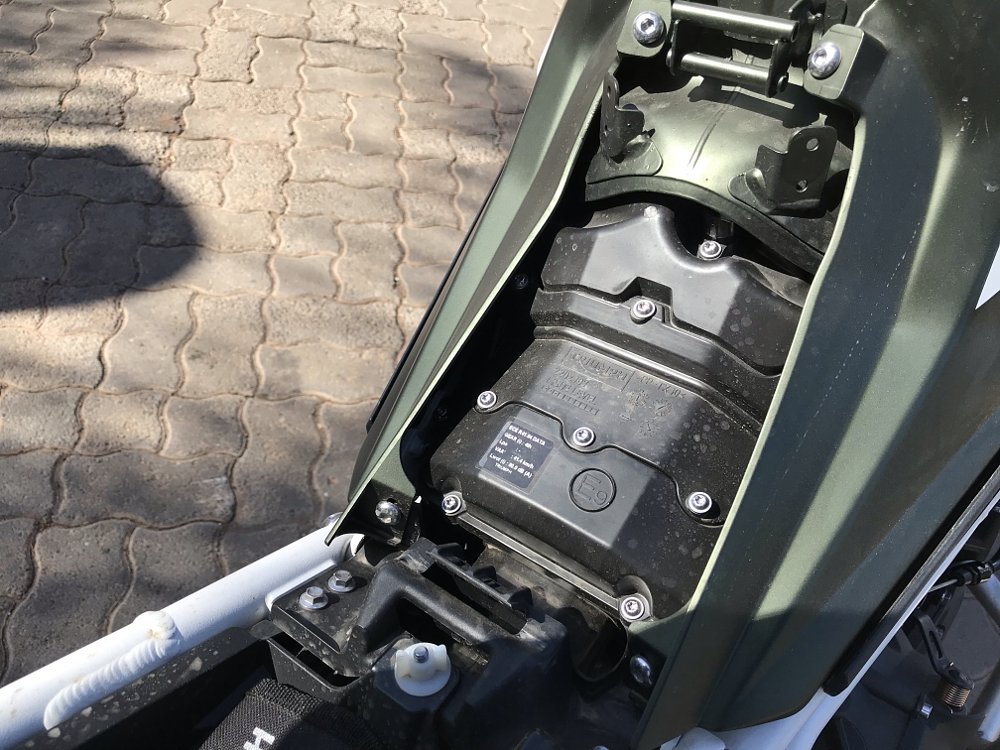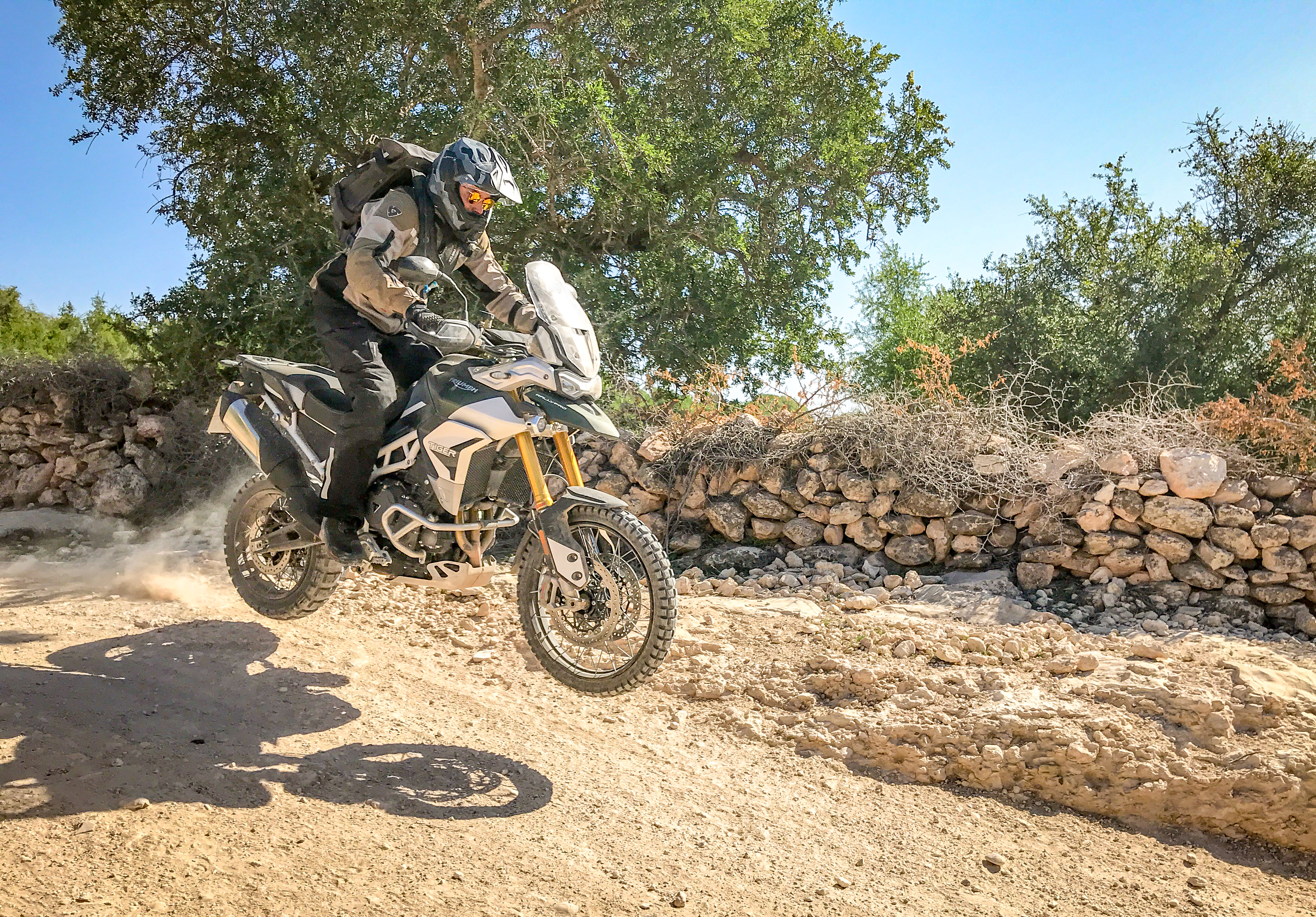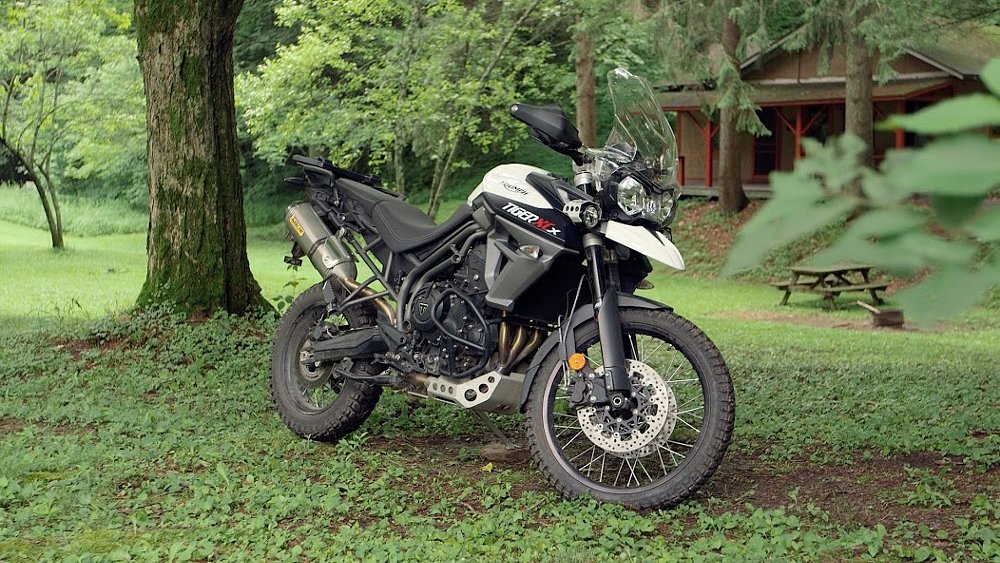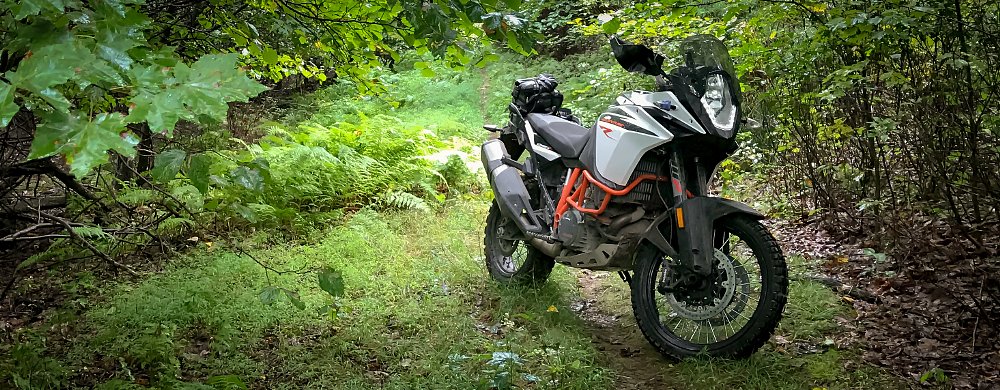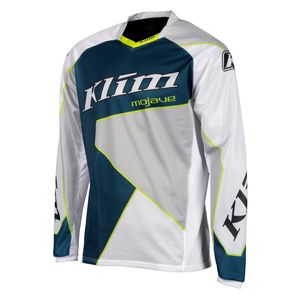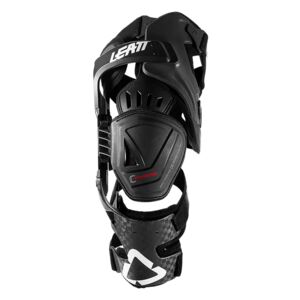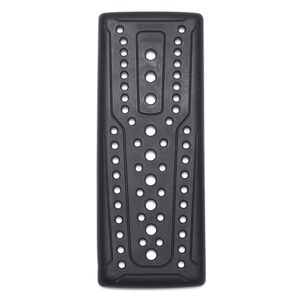According to the claims that Triumph made at the press introduction of the Tiger 900 last December, they would have you believe these new models are revolutionary new machines compared to the previous Tiger 800s.
Bold claims.
As a former owner of a 2015 Triumph Tiger 800 XCx and Common Tread’s resident adventure bike enthusiast, I took a personal interest in this new model. Triumph is positioning these new Tigers — GT models for primarily street use and Rally models for those who go off-road, replacing the XR/XC nomenclature — to be ground-up redesigns, better in every way than the previous Tiger 800s.
I wanted to see if reality measured up to the marketing, so I headed off to Morocco to ride both the Tiger 900 GT Pro and the Rally Pro to learn more about what had changed, but more importantly to see how those changes translate to the road. And of course, off-road.
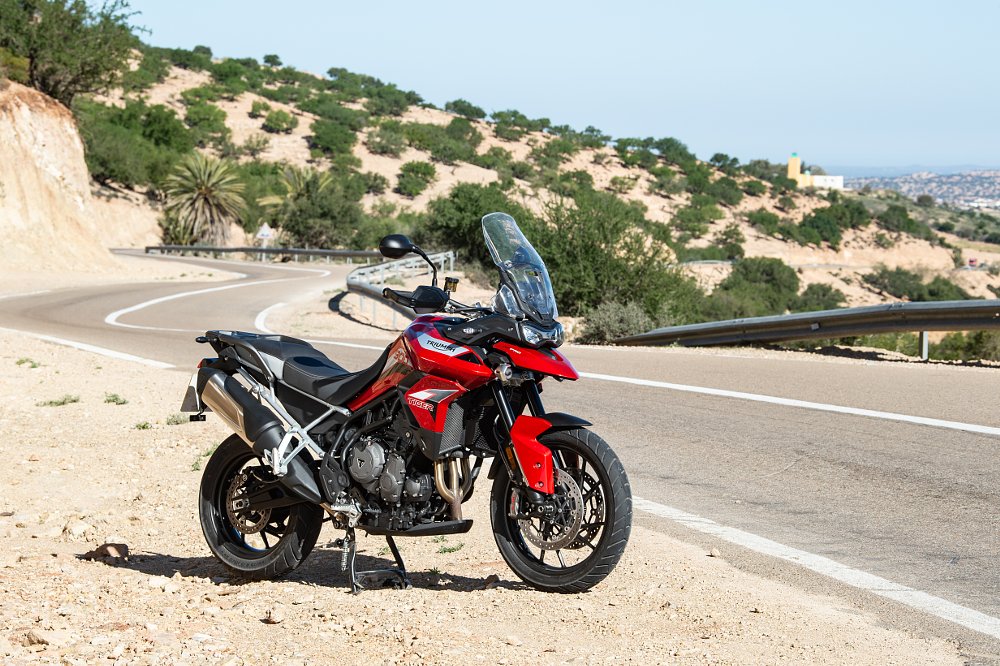
Tiger 900 engine
Reading through the press materials, it’s clear that Triumph has delivered pretty much a new machine with the Tiger 900, but nowhere is that more apparent than with the new 888 cc engine, which has a completely different feel, sound, and character. That being said, the major service intervals remain unchanged at 6,000 miles for oil changes and 12,000 miles for valve checks.
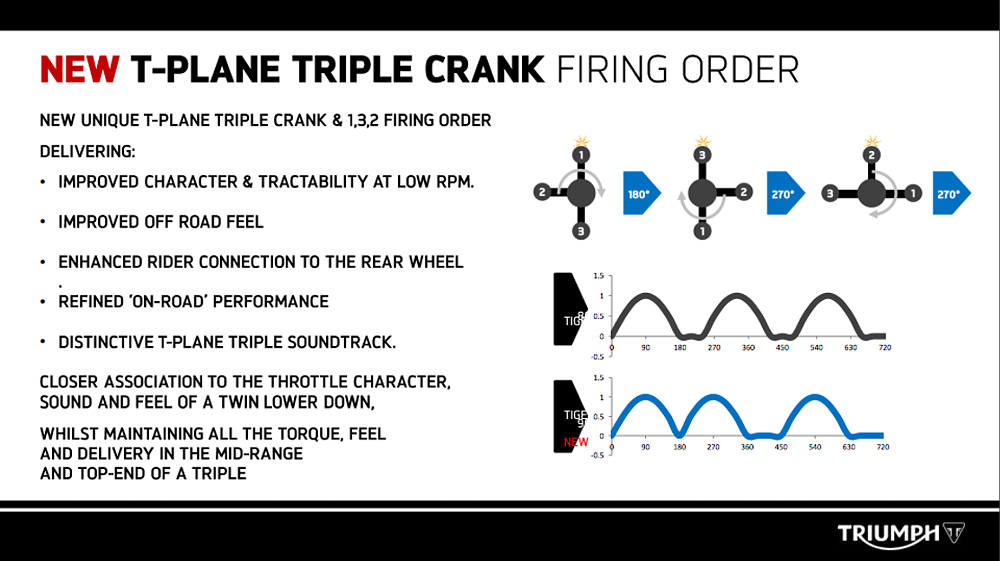
Without repeating too much of Mark Gardiner’s first look article, I want to focus on the crank. Where the previous engine had an even 1-2-3 firing order, the new “T-plane crank,” as Triumph is calling it, is really the first of its kind. It utilizes a 1-3-2 firing order with one and three firing closer together and the final hit in cylinder two comes after a break.
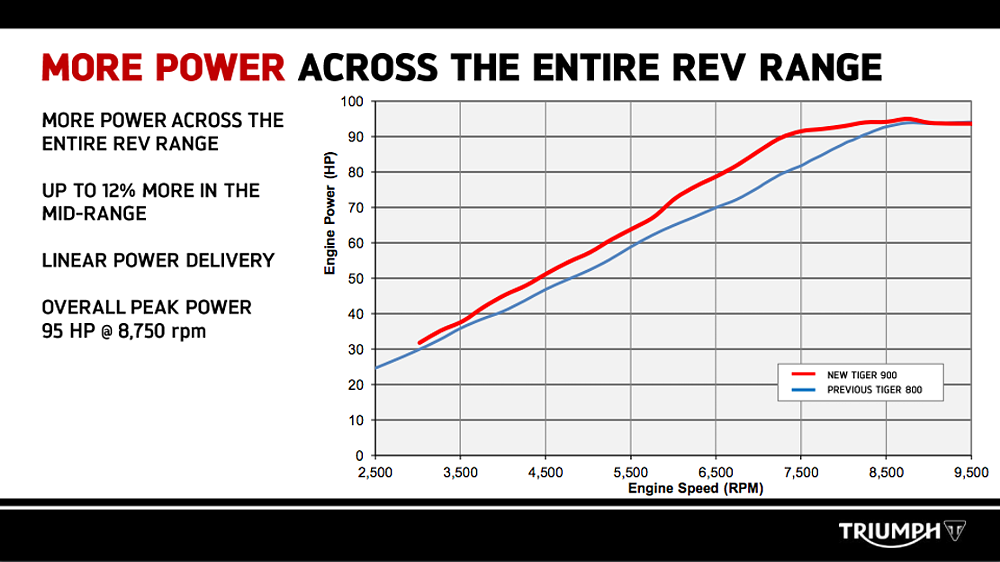
This gives the engine a completely different feel, arguably for the better. It pulls stronger right out of the gate, but not with as much urgency as the Yamaha triples. It spins up strong and evenly and allows the bike to be ridden comfortably between 2,500 rpm and 7,000 rpm. I kept looking down at the tachometer, expecting to be higher in the rev range, based on my experience with the previous engine.
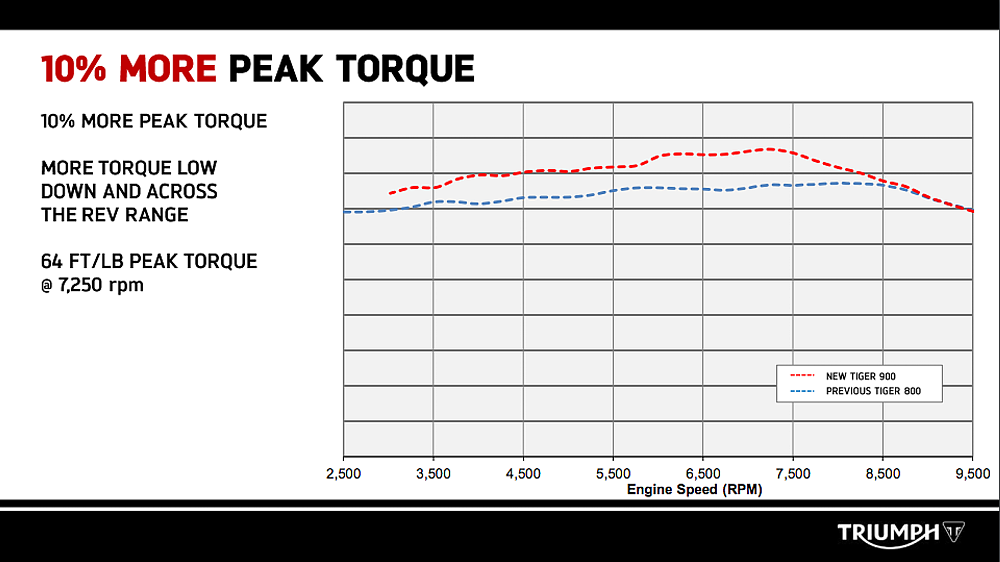
While torque has increased to 65 foot-pounds at 7,250 rpm, top-end horsepower remains the same at 95 horsepower at 8,750 rpm. I absolutely commend Triumph for this. Instead of just increasing displacement and throwing an extra few ponies up top, they instead offered a better overall experience by improving performance where most riders are going to use it.
I think the theme of this review could actually be the fact that Triumph listened to Tiger 800 owners as they designed this new bike. And a perfect example of that is the location of the new airbox.
In order to get to the air filter on the previous model, one had to remove the radiator shrouds, tank shrouds, and finally the tank itself before reaching the airbox, which had a multitude of screws holding it into place. The ritual would take upwards of an hour, and that is if you were fast and familiar with the work.
The new air filter is located underneath the seat. You have to remove four bolts holding on the lower tank shrouds and then six screws to release the cartridge air filter. The process from start to finish might take you 10 minutes. For those of you not familiar with riding these bikes off-road, this is such an important advancement because you need to check your air filter much more regularly. In extremely dusty conditions, you’ll want to check it or clean it (if you swap to a reusable filter, which I recommend) after every ride.

Tiger 900 chassis
One of the biggest complaints about the previous Tiger 800 was that the passenger foot pegs were not removable. Instead they were welded to the sub-frame which was, in turn, welded to the frame. There were two problems with that.
First, many riders like to remove those pegs when riding off-road so they don’t interfere with moving around on the bike. That wasn’t possible with the previous Tiger. The second problem with this design is that it makes it really easy to damage the frame of the bike in an off-road crash. There were multiple reports of Tiger owners who bent a passenger foot peg mount in a crash and had to get a new frame from Triumph. The Tiger 800 was the only ADV bike I can think of with this design in 2019.
With the new 2020 Tiger 900, the rear aluminum sub-frame is now removable, with four mounting points to a new steel trellis frame. The passenger pegs are also removable, allowing for better range of motion for the rider in off-road scenarios.

The only downside here is that I feel like the fit and finish on the welds aren't up to what I've come to expect from Triumph. Also the size of the bungs where the passenger pegs attach to the sub-frame are smaller than the outside diameter of the peg mounts. Overall it just looks sloppy.
There are some discrepancies in the literature Triumph provided, but the weight of the new Tiger 900 is up to 16 pounds lighter than the previous Tiger 800. But what is important to note is that it feels much lighter by comparison because of the distribution of the weight.
The engine now sits 20 mm (0.8 inches) lower in the frame than the previous version and 40 mm (1.5 inches) further forward, as measured from the center of the crank. The engine is also angled forward roughly six degrees. You’ll notice the radiator at the front of the bike is now split to accommodate this change. Because the new engine requires less oil, they were able to reduce the size of the sump. Therefore, ground clearance was actually improved in spite of the fact that the engine sits lower in the frame.

Tiger 900 brakes and wheels
The new Tiger is slowed down using Brembo Stylema four-piston calipers, which replace the old Nissins. The brake rotor size has increased from 305 mm to 320 mm and there is now a radial master cylinder. The rear brake is a single-piston Brembo caliper and a 255 mm disc.
Adjustment at the brake lever offers an extreme range of motion so you can precisely tune where the lever sits. Braking is drastically improved over the previous Nissin set-up. The initial bite is strong and the lever pull is comfortably progressive.
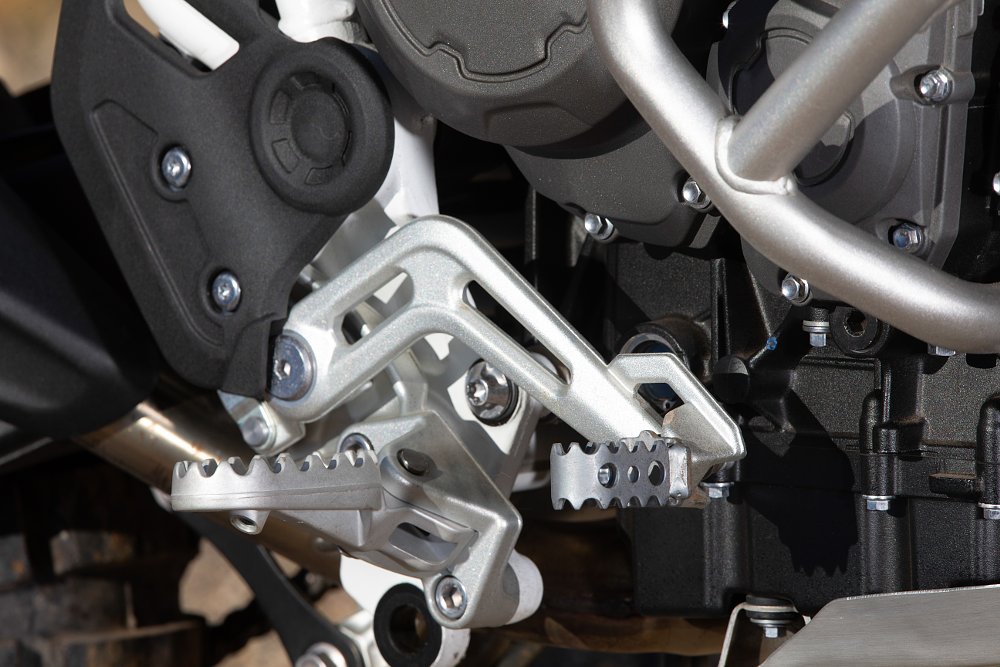
The big benefit for off-road riders is that the rear brake pedal on the Rally and Rally Pro is now the same as that found on the Scrambler 1200. It features two different positions, so when you’re riding in the standing position you have a much easier reach to the rear pedal, as well as improved braking feel.
The base Tiger, GT, and GT Pro all receive cast wheels, just like the previous XR line of Tiger 800s. The front wheel fits a 100/90-19 tire and the rear utilizes a 150/70R17.
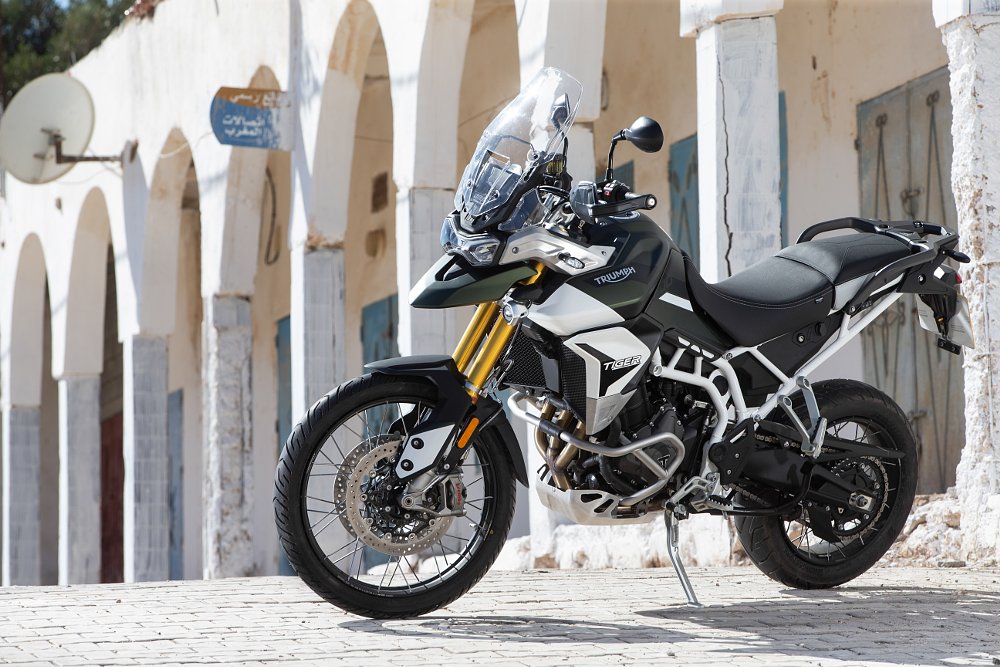
The Tiger 900 Rally and Rally Pro receive cross-spoked, tubeless rims, a feature not previously available on the Tiger 800 XC bikes. This means that riders sticking to the street can now get away with just carrying a tire plug kit. For those of you adventuring far off-road and running lower tire pressure, I would still recommend using a tube. If you’ve ever tried to set a bead on a bent rim off-road with a “tubeless” setup, you’ll know why. It’s a pain in the ass. That being said, the tubeless rims are a nice win for the majority of the ADV riders out there who aren’t handling much off-roading in their regular day-to-day.
I was disappointed that there is still no option for a more aggressive stock tire for the Rally and Rally Pro. All of the new Tiger 900s will ship with the more street-oriented Bridgestone Battlax Adventure A41 Tires. On our off-road day, we rode with Pirelli Scorpion Rally tires mounted to the rims. They still offered plenty of performance on the street, but their off-road grip was far superior to the stock rubber. Triumph should be shipping the Rally Pros with this tire, or at least offer it as a no-cost upgrade.

Tiger 900 suspension
Gone is the WP suspension found on the XC variants of the Tiger. The new Tiger 900 Rally and Rally Pro are fitted with a fully adjustable Showa suspension.

The front fork is now 45 mm in diameter and features adjustment for compression and rebound damping, as well as preload. The rear shock is adjustable for preload via a remote adjuster and rebound damping by a screw.
Suspension travel for the Rally versions has increased to 240 mm (9.44 inches) at the fork and 230 mm (9.05 inches) at the rear shock. To be clear, these are class-leading specs for off-road-focused ADV bikes. Only the KTM 790 Adventure R has more travel and only by 10 mm at the rear shock.

The base version of the Tiger 900, GT, and GT Pro are now suspended by a Marzocchi setup. The front fork is a 45 mm inverted unit with no adjustment on the base version. A bump to the GT or GT Pro gets you adjustment for compression and rebound damping, a first for the more road-focused Tiger. Travel at the fork is unchanged at 180 mm (7.1 inches).
The rear shock features a manual adjustment for preload on the base version. A bump to the GT adds an adjustment for rebound damping. The biggest change comes for folks who opt for the GT Pro, as it now features a rear shock that’s electronically adjustable for preload and rebound damping. Travel for all versions of this rear shock is 170 mm (6.7 inches).
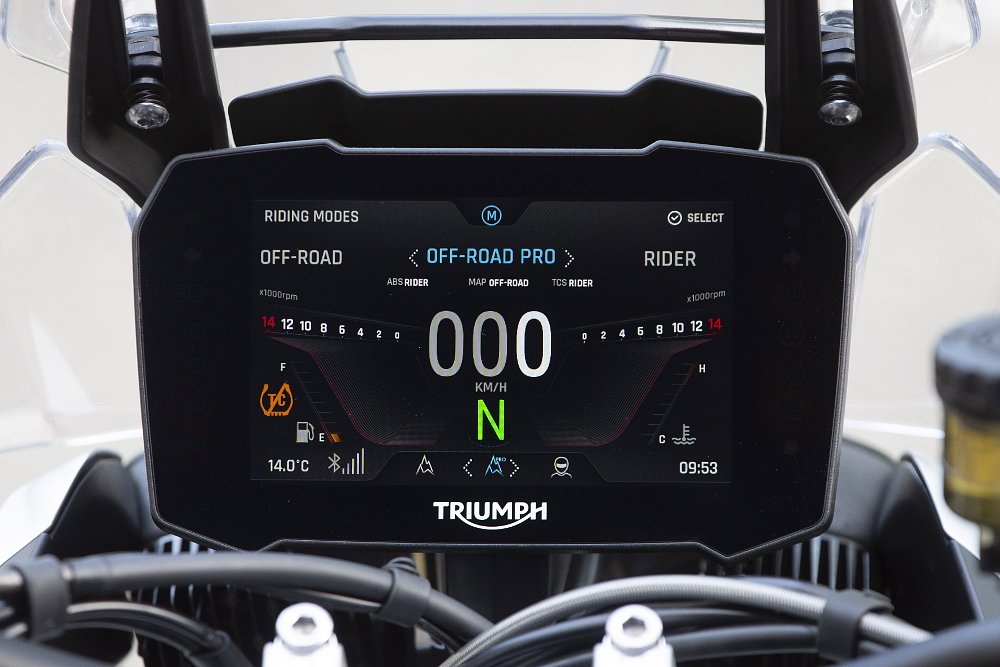
Tiger 900 electronics
At the top of the Tiger line, the GT Pro and Rally Pro come fully equipped with all of the electronic options available for these models. So we were able to test the bikes with all of the options available. And there were many.
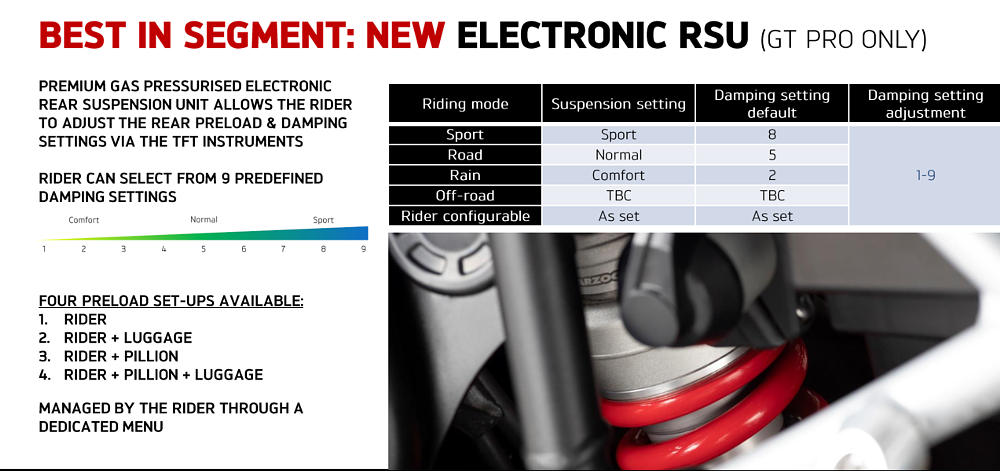
As mentioned above, adjustment for the rear shock on the GT Pro is tackled via the new seven-inch TFT dash (GT Pro and Rally Pro only). There are four options for pre-load settings and nine levels of rebound damping available ranging from comfort to sport. Pre-load settings are selectable as an individual setting, but damping settings can be selected one of two ways. Each of the riding modes has a predetermined damping setting but these can be overridden if you’d like to dial in more or less damping within a certain setting.
The GT Pro gets five rider modes, Road, Sport, Rain, Off-Road, and Rider. Rider mode allows you to configure the bike the way you’d like and save your options. It’s important to note that ABS cannot be turned off via this control setup. That option is reserved for a sixth riding mode, Off-Road Pro, which is only available on the Rally Pro.
I think this is an oversight on Triumph’s part. I don’t think it makes sense to make this mode available only in the Rally Pro version of the bike. Riders who are perfectly happy with the GT Pro or the base Rally should be able to configure the settings how they see fit. They shouldn’t have to bump to the Rally Pro in order to fully disable ABS and traction control. More on this later.

Each of the ride modes adjusts throttle response and intervention from the ABS, traction control, cornering ABS, and cornering traction control, the latter two being provided via a new Continental Inertial Measurement Unit (IMU). The base Tiger is the only one of the five models not to receive the IMU.
The two top-of-the-line models also get heated grips, heated seats (rider and pillion), a tire pressure monitoring system, and Triumph’s Shift Assist Pro, which allows for clutchless upshifts and downshifts. There is also a new version of the Triumph MyApp program for turn-by-turn directions available with these models. We got to try a BETA version of this but there proved to be quite a few connectivity issues. It’ll be interesting to see how that improves, because it worked really well when it was working.
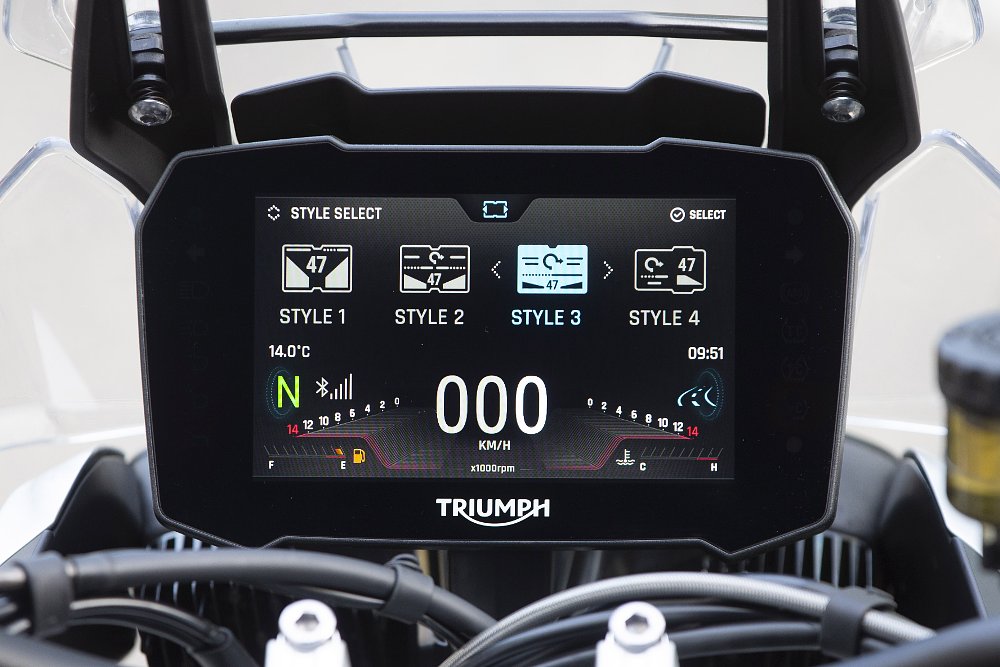
There are four different dash layouts available but my biggest gripe is that none of them provided a clear, easy-to-read tachometer layout. It was hard to see exactly where I was in the rev range.
Navigating the dash was a bit cumbersome, as well. I have used previous versions of Triumph’s TFT dashes so I was able to figure out the layout relatively quickly. However, some of my colleagues who haven’t had the same previous level of exposure to Triumph products struggled to figure out exactly where to find certain features without a lot of back and forth. More so than ever before, I’d recommend new Triumph Tiger 900 owners spend some considerable time with their owners manuals before heading out for a ride.

Riding the Tiger 900 on the road
We started out with a street ride that had us leaving Marrakesh early on Saturday morning and ending the day south of the coastal city of Essaouira. Throwing a leg over the Tiger 900, the first thing this previous Tiger owner noticed was the engine.
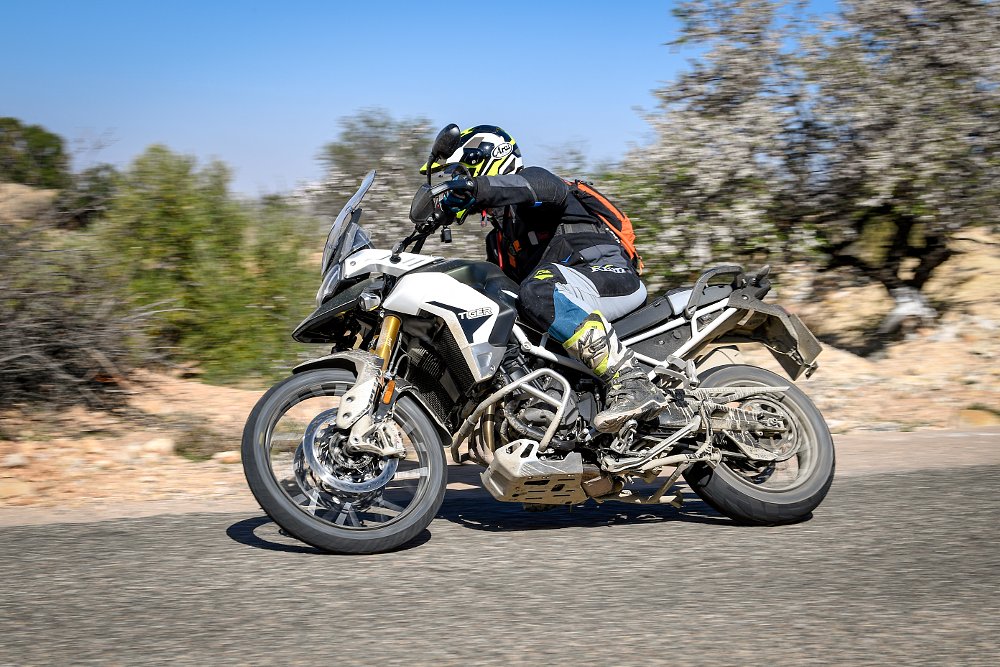
I love it so much more than the outgoing Tiger 800 plant. Power comes on much sooner and stronger. The low- to mid-range grunt is immediately noticeable. And the sound and feel are impressive. The only downside I noticed was that right around 6,500 rpm there is a slight buzziness in the hand grips and the seat that continues up to the redline, right around 10,000 rpm. However, this bike will cruise at 85 mph in sixth gear well before this starts becoming noticeable.
The roads we were riding were broken and bruised with potholes, gravel, and sand. They were perfect for testing the versatility of an adventure bike’s suspension. On the street, the Rally Pro’s suspension felt plush, if not a little soft. I found myself wondering about how it was going to fare in the off-road portion of the ride. It’s important to note, however, that up until this point I had made no adjustments to the suspension settings.

After a coffee break, I swapped over to the GT Pro and the differences between the two bikes were immediately apparent. The GT Pro, with its shorter suspension and smaller diameter wheels, feels much more like a compact sport-touring bike with a comfortable upright riding position. I electronically dialed in the suspension to the sporty end of the spectrum and the performance was impressive.
It’s important to note that the seat height on the GT is more approachable than the Rally’s, not having changed over the previous XR. There are two different positions for each model. The GT Pro can be set at 31.9 inches in the low setting and 32.7 inches in the tall setting. The Rally Pro ranges from 33.5 to 34.25 inches. There is an accessory comfort low seat which lowers the stock seat height roughly three fourths of an inch. There is also a “Low Suspension” version of the GT.

At five feet, six inches tall, Kelly Callan from Ultimate Motorcycling was the shortest rider in our group. She was able to flat-foot the GT Pro in the lowest seat setting and was on her tippy-toes on the Rally Pro in the tallest setting. She said if she were to opt for a Rally Pro, the low setting of the stock seat was plenty comfortable for her. However it’s nice to know the low seat is available as an option.
By comparison, at six feet, three inches, I was able to flat-foot the Rally Pro in the tallest position. The tank is restyled over the previous Tiger 800 and allows for a more comfortable reach to the ground and is easier to ride while standing. Overall, this line of Tiger 900 remains one of the most approachable and customizable bikes for riders of varying sizes. KTM could stand to learn a thing or two in this department.

Riding the Tiger 900 off-road
We kicked off our second day of riding on the beach just past the ruins of the Dar Sultan Palace south of Essaouira. For this day everyone was riding Tiger 900 Rally Pros with Scorpion Rally tires and the center stands and passenger pegs removed. As someone who has ripped a center stand spring off of a bike off-road before, I understood this particular preparation.

Whereas the engine was the first thing I noticed while riding on the street, it was the chassis that caught my attention immediately in the sand. The bike was drastically more balanced off-road. It’s not nearly as twitchy as the Tiger 800. It feels planted and confident in loose sand and rock.
The Rally Pro’s suspension had been tuned for us on the second day by former Dakar Rally racer Alex Busquets. On my bike, compression and rebound damping on the front fork were both set at 10 clicks (turn the clickers all the way out and then turn in 10 clicks) and each tube got 20 mm of preload (turn the clickers all the way out and then give them 20 full rotations). For the rear shock, the preload was set at the normal off-road setting in the owner's manual and the rebound screw received three fourths of a turn open from the fully closed position.
I took the time to get these settings from Alex because they worked perfectly. Steve Kamrad and I convinced our ride leader, Gary Morgan (an instructor at the Triumph off-road riding academy), to let us spend some time jumping the bikes off of a rock formation at the top of a long downhill section. We told him it would help with our “testing.” (Stuck with me and Steve all day, Gary was clearly a patient man.) Despite the jumping antics, we only bottomed out the suspension once the entire day. And the one time it happened, it hit the suspension stops, not the skid plate, which was a big improvement over the previous Tiger 800s. It appears that the claimed improved ground clearance is in fact a reality.
I preferred Off-Road Pro mode to regular Off-Road mode. Off-Road mode allows for some wheel slip before traction control kicks in helping riders new to off-road riding manage their experience. I found it too intrusive for times when I was looking for more wheel slip through the corner or in sand and loose gravel.
As I mentioned earlier, I am disappointed I can’t have Off-Road Pro mode in the base Rally trim. I don’t need heated seats, Triumph’s additional protection parts, or a quickshifter, but I do need Off-Road Pro mode to really ride this bike to its fullest potential off-road.
Riding without traction control for the majority of the day, I was very impressed with the amount of traction the engine was able to find. When I read Triumph’s marketing talk about the new engine and how the revised crank and firing order were going to help the bike maintain grip at the rear wheel, I immediately chalked it up as marketing talk. I was wrong.

After riding through a particularly loose uphill rocky section, Steve and I pulled over and just kind of gave each other a knowing look. Whereas the previous Tiger would just start to spin its rear wheel, this new bike digs in and hooks up. The throttle response is vastly improved and the bike doesn’t stall as easily as the previous 800. I think the slipper/assist clutch might have a hand in that.
For all of the improvements Triumph made, I was still disappointed with the crash protection. I don’t think aluminum-backed handguards are too much to ask for and the skid plate struck me as rather flimsy. I would love the larger, sharper rally footpegs that used to come on the XCA as I found my feet slipping off of the stock option, especially after water crossings. As for the crash bars, the jury is still out as I didn’t have an opportunity to test those at this launch.

Pricing and competition
The Triumph Tiger 900 GT Pro has an MSRP of $16,200 and the Tiger Rally Pro will set you back $16,700. If you can sacrifice some of the niceties and electronic suspension that the GT Pro provides, you could consider the base Tiger for $12,500 or the standard GT for $14,300.
For those of you who really want to push your Tiger 900 off-road, I’d recommend going with the Rally Pro over the base Rally ($15,000) for the aforementioned reasons surrounding the Off-Road Pro setting.
Historically, the battle for the middleweight adventure bike title has been between the Triumph Tiger 800 and the BMW F 800 GS, so let’s start there. The fully loaded F 850 GS that I rode last year in Moab had an MSRP of $16,920. The Tiger 900 Rally Pro offers improved adjustability and better travel from the suspension and slightly more power and feel from the engine. For the first time ever, I’d argue that the Triumph has surpassed the BMW in off-road performance while maintaining its on-road manners. That being said, for folks who don’t like to manually adjust their suspension, BMW does have an electronically adjustable rear shock.
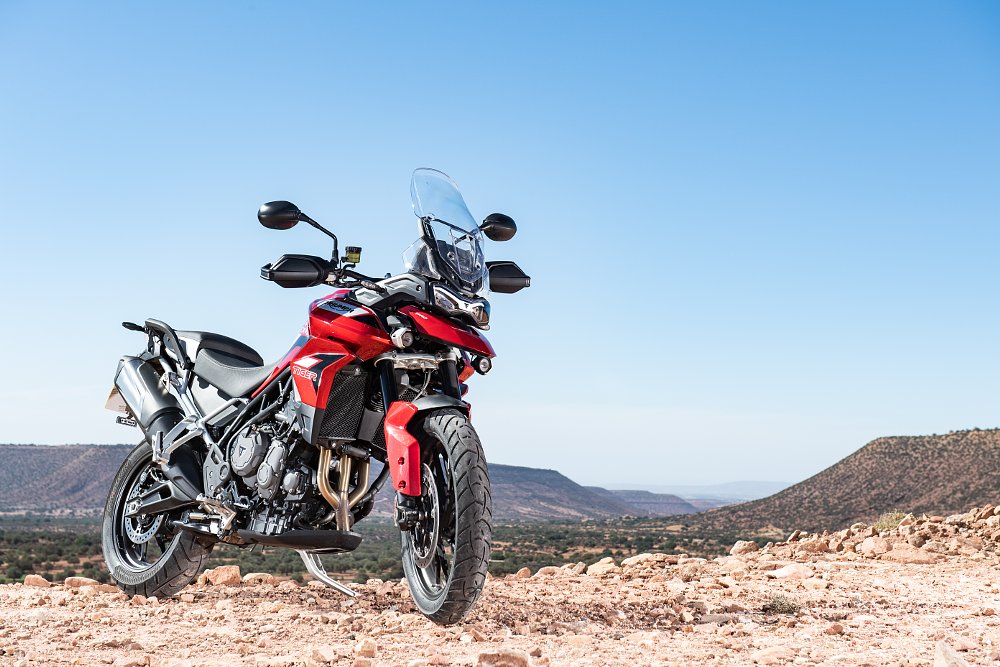
If you were to compare the top-of-the-line Tiger 900 GT Pro against the more street-focused F 750 GS, you’d have to measure it against BMW’s top-of-the-line package for $14,095. For the first time since the 750’s introduction, the Triumph now offers more features than BMW in this particular road-going package. You get a fully adjustable suspension, more power, and better stock comfort amenities. The GT Pro will also run you roughly $2,200 more than the BMW.
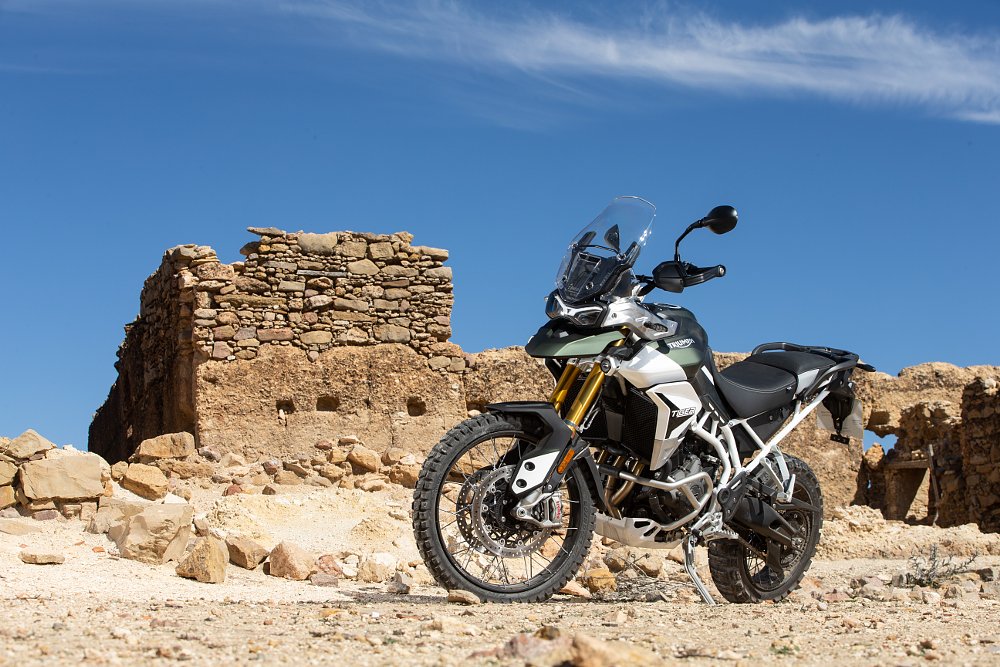
I am guessing that a lot of folks will also consider the new Tiger 900 Rally Pro against a KTM 790 Adventure R ($13,499), a bike I have not yet had an opportunity to ride. While the KTM comes in at an attractive price, you’d have to add quite a few niceties to put it on par with the Triumph. That being said, the $3,200 price difference will buy you a lot of goodies. I think where you’ll see the Tiger 900 win is in its approachable nature. It’s not as intimidating as the extremely tall KTM. It’s also set up to be a little more of a compromise between the street and off-road, whereas the KTM is positioned more toward the dirt side of the spectrum.
There are even more ADV bikes on their way in 2020. The Tiger 900 was just the first to show up. It’ll be interesting to see how Honda’s newest version of the Africa Twin compares and Yamaha keeps promising us that new Ténéré 700. One thing is for sure, if you’re a fan of adventure bikes, you face no shortage of available options.
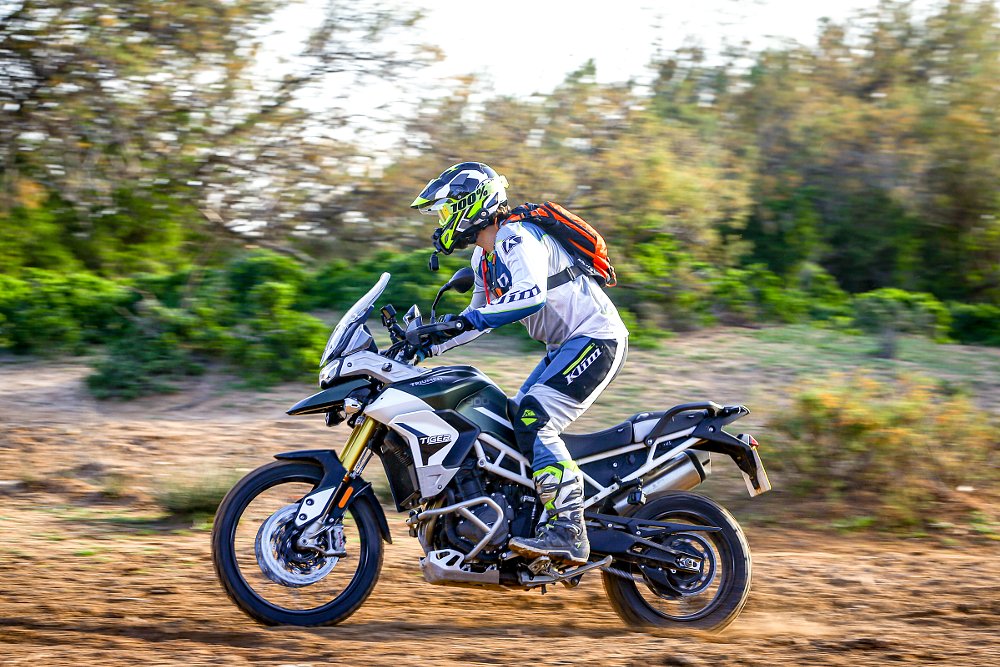
Conclusion
I think that for anyone out there looking at an adventure bike, it’s extremely important to be honest with yourself about what kind of riding you’re going to take on. The Tiger 900 GT Pro and Rally Pro are two very different machines. If you know you will stick to the street for 90 percent of the time with a few dirt and gravel roads thrown in here and there, go with the GT or GT Pro. It’s an excellent sport-touring adventure bike.
However, if you’re like myself and you really want to challenge yourself off-road, then the Rally Pro is the no-brainer choice between the two. I couldn’t stop smiling while riding this thing off-road. If it were up to me, I would have spent the entire trip tracking down trails to ride.
I went into this review completely skeptical. I felt like Triumph was blowing smoke about how much better this new bike was going to be. I was incredibly wrong. The new Tiger blows away the previous Tiger 800 in nearly every way. I would challenge anyone out there on a Tiger 800 to find yourself a test ride on the new 900 and try to disagree.
| 2020 Triumph Tiger 900 Rally Pro | 2020 Triumph Tiger 900 GT Pro | |
|---|---|---|
| Price (MSRP) | $16,700 | $16,200 |
| Engine type | Liquid-cooled, 12-valve, DOHC, inline 3-cylinder | Liquid-cooled, 12-valve, DOHC, inline 3-cylinder |
| Displacement | 888cc | 888cc |
| Bore x stroke | 78 mm x 61.9 mm | 78 mm x 61.9 mm |
| Compression | 11.27:1 | 11.27:1 |
| Horsepower | 93.9 at 8,750 rpm | 93.9 at 8,750 rpm |
| Torque | 64 foot-pounds at 7,250 rpm | 64 foot-pounds at 7,250 rpm |
| Transmission | Six-speed, wet, multi-plate clutch, with shift assist | Six-speed, wet, multi-plate clutch, with shift assist |
| Front suspension |
Showa 45 mm inverted fork, manual preload, rebound and compression damping adjustment |
Marzocchi 45 mm inverted fork, manual rebound and compression damping adjustment |
| Rear suspension | Showa rear suspension unit, manual preload and rebound damping adjustment | Marzocchi rear suspension unit, electronically adjustable preload and rebound damping |
| Front suspension travel | 9.44 inches (240 mm) | 7.08 inches (180 mm) |
| Rear suspension travel | 9.05 inches (230 mm) | 6.69 inches (170 mm) |
| Front brake | Twin 320 mm floating discs, Brembo Stylema four-piston Monoblock calipers. Radial front master cylinder, Multi-mode ABS, Optimized Cornering ABS | Twin 320 mm floating discs, Brembo Stylema four-piston Monoblock calipers. Radial front master cylinder, Multi-mode ABS, Optimized Cornering ABS |
| Rear brake | Single 255 mm disc, Brembo single-piston sliding caliper | Single 255 mm disc, Brembo single-piston sliding caliper |
| Tires front/rear | 90/90-21, 150/70R17 | 100/90-19, 150/70R17 |
| Wheelbase | 61.06 inches (1,551 mm) | 61.25 inches (1,556 mm) |
| Seat height | 33.46 - 34.25 inches (850 - 870 mm) | 31.88 - 32.67 inches (810 - 830 mm) |
| Rake | 24.4 degrees | 24.6 degrees |
| Trail | 5.74 inches (145.8 mm) | 5.24 inches (133.3 mm) |
| Tank capacity | 5.28 gallons (20 liters) | 5.28 gallons (20 liters) |
| Dry weight (claimed) | 443 pounds (201 kg) | 436.5 pounds (198 kg) |





